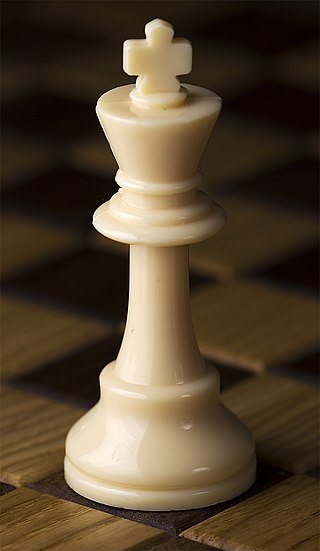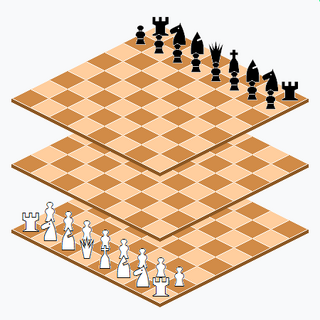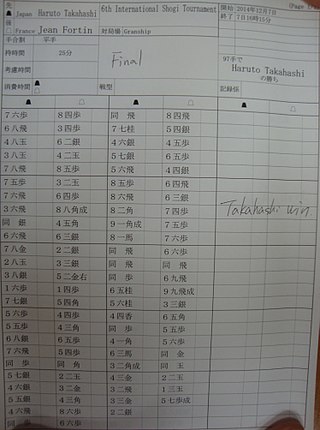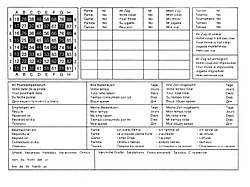
The king is the most important piece in the game of chess. It may move to any adjoining square; it may also perform, in tandem with the rook, a special move called castling. If a player's king is threatened with capture, it is said to be in check, and the player must remove the threat of capture immediately. If this cannot be done, the king is said to be in checkmate, resulting in a loss for that player. A player cannot make any move that places their own king in check. Despite this, the king can become a strong offensive piece in the endgame or, rarely, the middlegame.

A chess piece, or chessman, is a game piece that is placed on a chessboard to play the game of chess. It can be either white or black, and it can be one of six types: king, queen, rook, bishop, knight, or pawn.
Castling is a move in chess. It consists of moving the king two squares toward a rook on the same rank and then moving the rook to the square that the king passed over. Castling is permitted only if neither the king nor the rook has previously moved; the squares between the king and the rook are vacant; and the king does not leave, cross over, or finish on a square attacked by an enemy piece. Castling is the only move in chess in which two pieces are moved at once.

Algebraic notation is the standard method for recording and describing the moves in a game of chess. It is based on a system of coordinates to uniquely identify each square on the board. It is used by most books, magazines, and newspapers.

The rules of chess govern the play of the game of chess. Chess is a two-player abstract strategy board game. Each player controls sixteen pieces of six types on a chessboard. Each type of piece moves in a distinct way. The object of the game is to checkmate the opponent's king; checkmate occurs when a king is threatened with capture and has no escape. A game can end in various ways besides checkmate: a player can resign, and there are several ways a game can end in a draw.
Descriptive notation is a chess notation system based on abbreviated natural language. Its distinctive features are that it refers to files by the piece that occupies the back rank square in the starting position and that it describes each square two ways depending on whether it is from White or Black's point of view. It was common in English, Spanish and French chess literature until about 1980. In most other languages, the more concise algebraic notation was in use. Since 1981, FIDE no longer recognizes descriptive notation for the purposes of dispute resolution, and algebraic notation is now the accepted international standard.
This glossary of chess explains commonly used terms in chess, in alphabetical order. Some of these terms have their own pages, like fork and pin. For a list of unorthodox chess pieces, see Fairy chess piece; for a list of terms specific to chess problems, see Glossary of chess problems; for a list of named opening lines, see List of chess openings; for a list of chess-related games, see List of chess variants; for a list of terms general to board games, see Glossary of board games.
Circe chess is a chess variant in which captured pieces are reborn on their starting positions as soon as they are captured. The game was invented by French composer Pierre Monréal in 1967 and the rules of Circe chess were first detailed by Monréal and Jean-Pierre Boyer in an article in Problème, 1968.
Portable Game Notation (PGN) is a standard plain text format for recording chess games, which can be read by humans and is also supported by most chess software.
Forsyth–Edwards Notation (FEN) is a standard notation for describing a particular board position of a chess game. The purpose of FEN is to provide all the necessary information to restart a game from a particular position.
Chess notation systems are used to record either the moves made or the position of the pieces in a game of chess. Chess notation is used in chess literature, and by players keeping a record of an ongoing game. The earliest systems of notation used lengthy narratives to describe each move; these gradually evolved into more compact notation systems. Algebraic notation is now the accepted international standard, with several variants. Descriptive chess notation was used in English- and Spanish-language literature until the late 20th century, but is now obsolescent. Portable Game Notation (PGN) is a text file format based on English algebraic notation which can be processed by most chess software. Other notation systems include ICCF numeric notation, used for international correspondence chess, and systems for transmission using Morse code over telegraph or radio. The standard system for recording chess positions is Forsyth–Edwards Notation (FEN).
Yari shogi is a modern variant of shogi ; however, it is not Japanese. It was invented in 1981 by Christian Freeling of the Netherlands. This game accentuates shogi’s intrinsically forward range of direction by giving most of the pieces the ability to move any number of free squares orthogonally forward like a shogi lance. The opposite is true of promoted pieces which can move backward with the same power.
Judkins shogi is a modern variant of shogi, however it is not Japanese. Credit for its invention has been given to Paul Judkins of Norwich, UK, prior to April 1998.
Shō shōgi is a 16th-century form of shogi, and the immediate predecessor of the modern game. It was played on a 9×9 board with the same setup as in modern shogi, except that an extra piece stood in front of the king: a 'drunk elephant' that promoted into a prince, which is effectively a second king. While 9×9 may not seem 'small', it was smaller than the other shogi variants prevalent at the time, which were the 12×12 chu shogi and 15×15 dai shogi. According to the Sho Shōgi Zushiki, the drunk elephant was eliminated by the Emperor Go-Nara, and it is assumed that the drop rule was introduced at about the same time, giving rise to shogi as we know it today.

Hexagonal chess is a group of chess variants played on boards composed of hexagon cells. The best known is Gliński's variant, played on a symmetric 91-cell hexagonal board.
Omega Chess is a commercial chess variant designed and released in 1992 by Daniel MacDonald. The game is played on a 10×10 board with four extra squares, each added diagonally adjacent to the corner squares. The game is laid out like standard chess with the addition of a champion in each corner of the 10×10 board and a wizard in each new added corner square.

Millennium 3D chess is a three-dimensional chess variant created by William L. d'Agostino in 2001. It employs three vertically stacked 8×8 boards, with each player controlling a standard set of chess pieces. The inventor describes his objective as "extending the traditional chess game into a multilevel environment without distorting the basic game."

The following outline is provided as an overview of and topical guide to chess:
Dynamo chess is a chess variant invented by chess problemists Hans Klüver and Peter Kahl in 1968. The invention was inspired by the closely related variant push chess, invented by Fred Galvin in 1967. The pieces, board, and starting position of Dynamo chess are the same as in orthodox chess, but captures are eliminated and enemy pieces are instead "pushed" or "pulled" off the board. On any given move, a player can make a standard move as in orthodox chess, or execute a "push move" or a "pull move". A move that is either a push move or a pull move is called a "dynamo move".

Shogi notation is the set of various abbreviatory notational systems used to describe the piece movements of a shogi game record or the positions of pieces on a shogi board.








